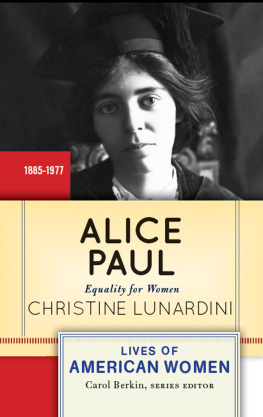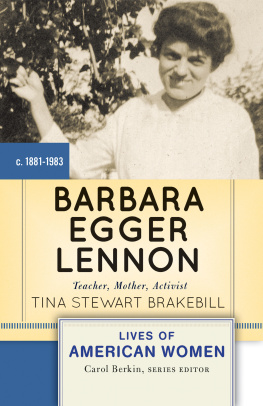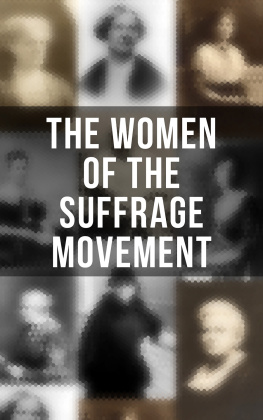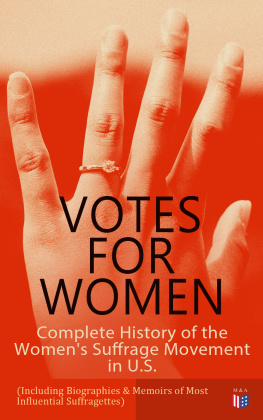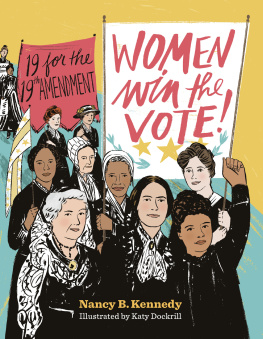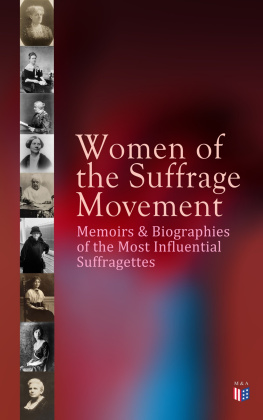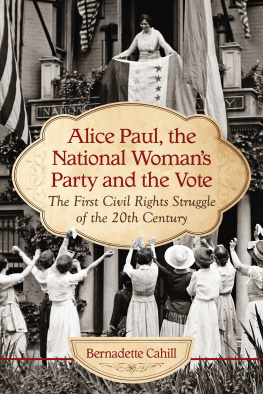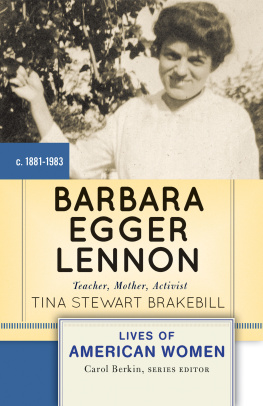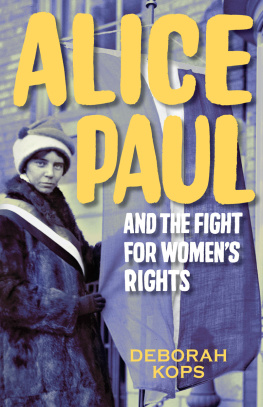PRAISE FOR
Lives of American Women
Finally! The majority of studentsby which I mean womenwill have the opportunity to read biographies of women from our nations past. (Men can read them too, of course!) The Lives of American Women series features an eclectic collection of books, readily accessible to students who will be able to see the contributions of women in many fields over the course of our history. Long overdue, these books will be a valuable resource for teachers, students, and the public at large.
COKIE ROBERTS,
author of Founding Mothers and Ladies of Liberty
Just what any professor wants: books that will intrigue, inform, and fascinate students! These short, readable biographies of American womenspecifically designed for classroom usegive instructors an appealing new option to assign to their history students.
MARY BETH NORTON, Mary Donlon Alger Professor of American History,
Cornell University
For educators keen to include women in the American story, but hampered by the lack of thoughtful, concise scholarship, here comes Lives of American Women, embracing Abigail Adamss counsel to Johnremember the ladies. And high time, too!
LESLEY S. HERRMANN,
Executive Director, The Gilder Lehrman
Institute of American History
Students both in the general survey course and in specialized offerings like my course on U.S. womens history can get a great understanding of an era from a short biography. Learning a lot about a single but complex character really helps to deepen appreciation of what womens lives were like in the past.
PATRICIA CLINE COHEN,
University of California, Santa Barbara
Biographies are, indeed, back. Not only will students read them, biographies provide an easy way to demonstrate particularly important historical themes or ideas . Undergraduate readers will be challenged to think more deeply about what it means to be a woman, citizen, and political actor . I am eager to use this in my undergraduate survey and specialty course.
JENNIFER THIGPEN,
Washington State University, Pullman
These books are, above all, fascinating stories that will engage and inspire readers. They offer a glimpse into the lives of key women in history who either defied tradition or who successfully maneuvered in a mans world to make an impact. The stories of these vital contributors to American history deliver just the right formula for instructors looking to provide a more complicated and nuanced view of history.
ROSANNE LICHATIN,
2005 Gilder Lehrman Preserve
America History Teacher of the Year
The Lives of American Women authors raise all of the big issues I want my classes to confrontand deftly fold their arguments into riveting narratives that maintain students excitement.
WOODY HOLTON,
author of Abigail Adams
Lives of American Women
Carol Berkin, Series Editor
Westview Press is pleased to launch Lives of American Women. Selected and edited by renowned womens historian Carol Berkin, these brief, affordably priced biographies are designed for use in undergraduate courses. Rather than a comprehensive approach, each biography focuses instead on a particular aspect of a womans life that is emblematic of her time, or which made her a pivotal figure in the era. The emphasis is on a good read, featuring accessible writing and compelling narratives, without sacrificing sound scholarship and academic integrity. Primary sources at the end of each biography reveal the subjects perspective in her own words. Study Questions and an Annotated Bibliography support the student reader.
Dolley Madison: The Problem of National Unity by Catherine Allgor
Lillian Gilbreth: Redefining Domesticity by Julie Des Jardins
Alice Paul: Equality for Women by Christine Lunardini
Rebecca Dickinson: Independence for a New England Woman by Marla Miller
Sarah Livingston Jay: Model Republican Woman by Mary-Jo Kline
Betsy Mix Cowles: Bold Reformer by Stacey Robertson
Sally Hemings: Given Her Time by Jon Kukla
Shirley Chisholm: Catalyst for Change by Barbara Winslow
Margaret Sanger: Freedom, Controversy and the Birth Control Movement by Esther Katz
Barbara Egger Lennon: Teacher, Mother, Activist by Tina Brakebill
Anne Hutchinson: A Dissident Womans Boston by Vivian Bruce Conger
Angela Davis: Radical Icon by Robyn Spencer
Catharine Beecher: The Complexity of Gender in 19th Century America by Cindy Lobel
Julia Lathrop: Social Service and Progressive Government by Miriam Cohen
Mary Pickford: Women, Film and Selling Girlhood by Kathy Feeley
Elizabeth Gurley Flynn: The Making of the Modern Woman by Lara Vapnek
First published 2013 by Westview Press
Published 2018 by Routledge
711 Third Avenue, New York, NY 10017, USA
2 Park Square, Milton Park, Abingdon, Oxon OX14 4RN
Routledge is an imprint of the Taylor & Francis Group, an informa business
Copyright 2013 Taylor & Francis
All rights reserved. No part of this book may be reprinted or reproduced or utilised in any form or by any electronic, mechanical, or other means, now known or hereafter invented, including photocopying and recording, or in any information storage or retrieval system, without permission in writing from the publishers.
Notice:
Product or corporate names may be trademarks or registered trademarks, and are used only for identification and explanation without intent to infringe.
Every effort has been made to secure required permissions for all text, images, maps, and other art reprinted in this volume.
Library of Congress Cataloging-in-Publication Data
Lunardini, Christine A., 1941-
Alice Paul : equality for women / Christine Lunardini.
p. cm.(Lives of American women)
Includes bibliographical references and index.
ISBN 978-0-8133-4761-5 (pbk. : alk. paper)ISBN 978-0-8133-4762-2 (e-book) 1. Paul, Alice, 18851977. 2. SuffragistsUnited States Biography. 3. WomenSuffrageUnited StatesHistory. 4. Womens rightsUnited StatesHistory. I. Title.
HQ1413.P38L86 2013
324.623092dc23
[B]
2012032769
ISBN 13: 978-0-8133-4761-5 (pbk)
When women gathered at Seneca Falls in 1848, their agenda was truly radical: they were challenging the norms and the values of their society. In an era when men and women were assigned separate spheres and full citizenship was available only to adult white males, these women called for nothing less than equal economic, educational, and political equalityand a dramatic shift in established notions of the intellectual and moral differences between the sexes.
The right to vote, or suffrage, was only one of the Seneca Falls conventions radical demands. But as the decades went by, many of the women who devoted time and energy to womens rights took a narrower view of their agenda. By the time Alice Paul was born in 1885, winning the vote had become the central, if not the only, goal of the movement. In Paul, however, the spirit of Seneca Falls lived on. Over her remarkable lifetime, she campaigned tirelessly for full equality of the sexes. For Paul, suffrage was only a first step; the ultimate goal had to be a nation fully committed to gender equality. This, she argued, could be achieved only through the passage of an equal rights amendment.

